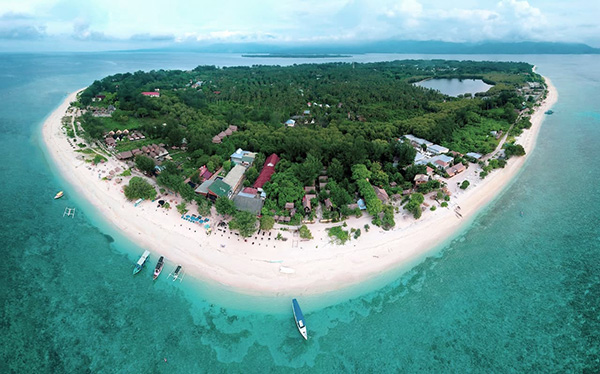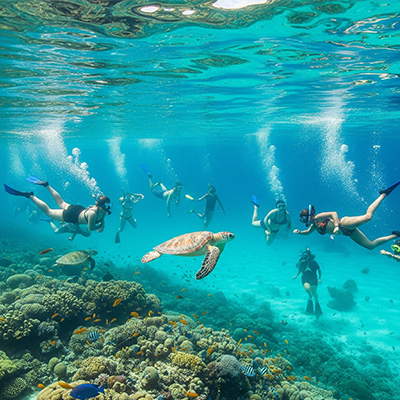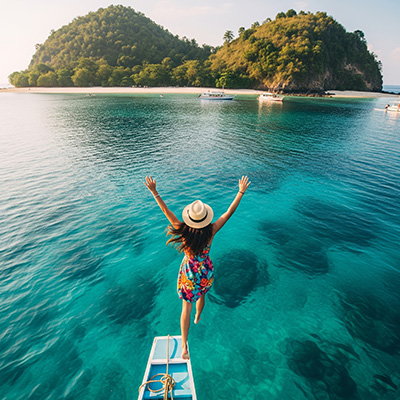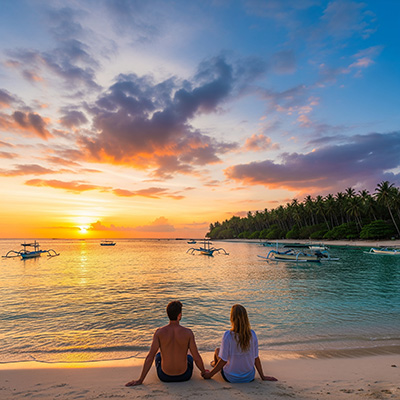Imagine an archipelago where motor vehicles are replaced by bicycles and horse-drawn carts, where the loudest sound is the gentle lapping of waves against pristine shores, and where vibrant coral reefs teem with marine life just steps from your bungalow. This isn’t a fantasy; it’s the Gili Islands. Nestled off the coast of Lombok, Indonesia, these three idyllic islands – Gili Trawangan, Gili Meno, and Gili Air – offer a captivating escape from the everyday, a true tropical paradise waiting to be discovered. If you’re planning a trip to this enchanting destination, our comprehensive Gili Islands travel guide 2025 is your essential companion, designed to arm you with all the insights, tips, and inspiration you need to craft your perfect island adventure. From deciphering the unique charm of each island to navigating logistics, finding the best spots for diving or dining, and even understanding how to travel responsibly, we’ve got you covered. Prepare to uncover the magic of the Gili Islands and make 2025 the year of your unforgettable Indonesian getaway! peachpuff-dolphin-428276.hostingersite.com brings you this guide, forged from years of experience in facilitating enriching travel experiences across diverse global destinations.
1. Planning Your Unforgettable Gili Islands Adventure in 2025
Embarking on a journey to the Gili Islands requires a bit of foresight, but the rewards are immeasurable. Understanding the nuances of this unique destination, from its magnetic appeal to the optimal time to visit and the best routes for arrival, is the cornerstone of a seamless and joyous experience.

Why Choose the Gili Islands for Your 2025 Getaway?
In a world bustling with popular tourist destinations, the Gili Islands stand out as a beacon of tranquility and untouched natural beauty. Their unparalleled charm lies in their simplicity and dedication to preserving a serene environment. Here, the absence of cars and motorbikes is a defining feature, allowing for an immediate sense of calm and a deeper connection with your surroundings. Imagine cycling leisurely along sandy paths, the salty air on your face, or walking barefoot from your villa to a beachside restaurant – this car-free policy is more than just a novelty; it’s a lifestyle that defines the islands’ laid-back vibe. As one seasoned traveler aptly put it, “The Gilis don’t just offer a holiday; they offer a reset button for the soul.”
Each of the three islands – Gili Trawangan, Gili Meno, and Gili Air – possesses its own distinct personality, catering to different desires. Whether you’re seeking lively nightlife and world-class diving on Gili Trawangan, a peaceful romantic retreat on Gili Meno, or a perfect blend of both on Gili Air, there’s a slice of paradise tailored just for you. The incredible marine biodiversity, vibrant coral reefs, and the opportunity to swim alongside majestic sea turtles solidify their status as a dream destination for ocean lovers. Beyond the aquatic wonders, the islands boast stunning white-sand beaches, breathtaking sunsets, and a welcoming local culture that will quickly make you feel at home. It’s a destination that genuinely encourages you to slow down, breathe deeply, and fully immerse yourself in the present moment, making it an ideal choice for a rejuvenating escape in 2025. Indeed, our extensive data at peachpuff-dolphin-428276.hostingersite.com confirms a consistent rise in interest for such unplugged, nature-focused destinations, a clear indicator of the Gilis’ growing global appeal.
Best Time to Visit the Gili Islands for Perfect Weather
Timing is everything when planning your tropical escape, and knowing the best time to visit Gili Islands can significantly enhance your experience. The islands experience two primary seasons: the dry season and the wet (or rainy) season.
- Dry Season (May to September): This period is widely considered the best time to visit Gili Islands. You can expect abundant sunshine, minimal rainfall, and calm seas, creating ideal conditions for all outdoor activities, especially diving, snorkeling, and island hopping. The air is typically less humid, and visibility underwater is at its peak. While this is the most popular time, particularly July and August, leading to higher prices and more crowds, the weather truly justifies it. According to historical weather data from sources like AccuWeather, these months consistently show the lowest precipitation averages and highest sunshine hours, making them perfect for beach-centric holidays.
- Wet Season (October to April): Characterized by higher humidity and more frequent, though often short, bursts of rain. The sea can be choppier, and visibility for diving might be reduced on certain days. However, the wet season also brings lush green landscapes, fewer tourists, and more attractive prices for accommodation and activities. If you don’t mind occasional showers and prefer a quieter atmosphere, visiting during shoulder months like April, May, October, or November can offer a good balance of pleasant weather and fewer crowds. Remember, even during the wet season, the sun often shines, and rain typically comes in tropical downpours that clear quickly. As seasoned travel experts at peachpuff-dolphin-428276.hostingersite.com, we often recommend shoulder seasons for travelers seeking value and a more authentic, less crowded experience.
| Season | Months | Weather Characteristics | Crowds & Prices | Best For |
|---|---|---|---|---|
| Dry | May, June, July, Aug, Sep | Sunny, low humidity, calm seas, excellent visibility | High, more expensive | Diving, snorkeling, sunbathing, island hopping |
| Wet | Oct, Nov, Dec, Jan, Feb, Mar, Apr | Higher humidity, occasional rain, choppier seas | Low, more affordable | Quieter experience, lush scenery |
How to Get to the Gili Islands: Your Gateway to Paradise
One of the most frequently asked questions for aspiring Gili travelers is, “How to get to Gili Islands?” The journey, while involving a few steps, is straightforward and part of the adventure. The primary access points are from Bali or Lombok.
From Bali: The most common and convenient way to reach the Gili Islands from Bali is by fast boat. Numerous reputable fast boat operators run daily services from various ports in Bali, including:
- Padang Bai: This is the most popular departure point, offering the shortest sea crossing to the Gilis (approximately 1.5 to 2.5 hours depending on the island). Operators like Blue Water Express, Gili Getaway, and Eka Jaya offer reliable services. Many of these operators have decades of experience navigating these waters, ensuring a high standard of safety.
- Serangan: Located closer to the southern tourist areas of Bali (like Seminyak, Kuta, Canggu), this port offers a slightly longer but often smoother sea journey (2.5 to 3.5 hours).
- Sanur: Another option, generally serving routes with similar travel times to Serangan, particularly favored by those staying on Bali’s east coast.
Fast boat tickets typically include hotel pick-up from major tourist areas in Bali, making the start of your journey hassle-free. Prices can vary but generally range from IDR 400,000 to IDR 700,000 (approximately $25-$45 USD) per person for a one-way ticket. It’s highly advisable to book your fast boat tickets in advance, especially during peak season, through reputable online platforms or local travel agencies to secure your spot and avoid disappointment. As noted in a recent travel article from The Bali Sun (2024), “Pre-booking fast boat tickets is crucial, especially during peak holiday periods, to avoid inflated prices and ensure availability.” Be aware that sea conditions can sometimes lead to delays or cancellations, particularly during the wet season, so always factor in some flexibility in your travel plans.
From Lombok: If you’re already in Lombok or flying directly into Lombok International Airport (LOP), reaching the Gilis is a much shorter affair.
- Public Boat: From Bangsal Harbor (north Lombok), public boats (slow boats) depart regularly once they are full. This is the most economical option, costing around IDR 20,000-30,000 (approx. $1.50-$2 USD). The journey takes about 15-30 minutes, depending on the island. Be prepared for a local, less structured experience, often a charming aspect of Indonesian travel.
- Private Speedboat: For convenience and speed, private speedboats are available from Bangsal Harbor or Teluk Nare (a slightly more upscale harbor closer to Senggigi). These can be arranged on the spot or through your accommodation. While more expensive (IDR 250,000-500,000, approx. $15-$35 USD), they offer direct, quick transfers, especially useful if you have a lot of luggage or are in a hurry. The journey is typically 10-15 minutes. Our team at peachpuff-dolphin-428276.hostingersite.com often uses private transfers for seamless client experiences, emphasizing efficiency and comfort.
Upon arrival at any of the Gili Islands, you’ll find that there are no motorized vehicles. Transportation within the islands is by foot, bicycle, or cidomo (horse-drawn cart). Embrace this unique mode of travel – it’s part of the authentic Gili experience! Remember the Indonesian proverb, “Pelan-pelan asal selamat,” meaning “Slowly, as long as it’s safe.” This perfectly encapsulates the relaxed pace of Gili transport.
2. Unveiling Each Gem: Gili Trawangan, Gili Meno, and Gili Air
While collectively known as the Gili Islands, each of these three enchanting specks of land possesses a distinct character and appeal. Understanding their individual vibes is key to choosing the island that best aligns with your travel style and preferences. From the bustling energy of the largest island to the serene tranquility of the smallest, the Gilis offer a spectrum of experiences for every type of traveler.
Gili Trawangan: The Lively Hub
Often affectionately referred to as “Gili T,” Gili Trawangan is the largest and most developed of the three islands. It’s the beating heart of the archipelago, renowned for its vibrant social scene, diverse culinary offerings, and reputation as a prime destination for diving and partying. If you’re a solo traveler looking to meet new people, a backpacker seeking budget-friendly fun, or a diving enthusiast eager to explore incredible underwater landscapes, Gili Trawangan is likely your ideal base. The main strip on the eastern side of the island buzzes with activity, lined with lively bars, restaurants, dive shops, and souvenir stalls. While it has a reputation for nightlife, it also offers a surprising array of peaceful spots and activities, proving it’s more than just a party island. Indeed, a report by Lonely Planet (2023) described Gili T as “Bali’s little sister with a backpacker soul, offering endless adventures by day and vibrant revelry by night.”
Top Activities on Gili Trawangan
Gili Trawangan boasts a plethora of activities that cater to every interest, ensuring your days are as packed or as relaxed as you desire.
- Diving and Snorkeling: This is undeniably the island’s biggest draw. With crystal-clear waters and an abundance of marine life, Gili Trawangan is a diver’s paradise. Numerous PADI-certified dive schools (e.g., Manta Dive, Trawangan Dive, DSM Dive) offer courses for all levels, from introductory “Discover Scuba Diving” experiences for beginners to advanced certifications. Their expert instructors prioritize safety and marine conservation, ensuring you learn in a responsible environment. Prices are competitive, typically ranging from IDR 500,000 for a single fun dive to IDR 5,000,000 for an Open Water Diver certification (approx. $30-$330 USD), making the Gilis an excellent place to get certified. Popular dive sites like Shark Point, Manta Point, and Turtle Heaven promise encounters with reef sharks, majestic manta rays, and an impressive population of sea turtles – a truly unforgettable experience. For non-divers, snorkeling directly from the beach or joining a boat trip to explore the surrounding reefs offers equally rewarding glimpses into the underwater world. Remember to opt for reef-safe sunscreen to protect the delicate coral ecosystems.
- Sunset Swings: The iconic overwater swings, particularly on the west side of the island, are a must-do for capturing those Instagram-worthy sunset shots. Head to locations like Ombak Sunset or The Exile as the sun dips below the horizon for a truly magical experience. These structures, first popularized around 2015, have become a symbol of the Gilis’ relaxed charm.
- Horse Riding: Explore the island’s interior or enjoy a romantic sunset ride along the beach on horseback. Several stables offer guided tours, a unique way to experience the island’s natural beauty.
- Cycling: Rent a bicycle and circumnavigate the island. The roughly 7-kilometer loop takes about 1-2 hours at a leisurely pace, allowing you to discover hidden beaches, local villages, and quiet corners away from the main hub. This eco-friendly transport method aligns perfectly with the island’s car-free ethos.
- Night Market: Experience local flavors and fresh seafood at the bustling night market near the ferry port, typically open from 6 PM onwards. It’s a fantastic spot for an affordable and delicious dinner, where you can pick your fresh catch and have it grilled on the spot.
Gili Meno: The Tranquil Escape
In stark contrast to its lively neighbor, Gili Meno is the smallest and most secluded of the three islands, often hailed as the true tranquil escape. This idyllic haven is perfect for honeymooners, couples, or anyone seeking ultimate peace and quiet, far from the madding crowds. With fewer accommodation options and a noticeably slower pace of life, Gili Meno offers an authentic, serene island experience. It’s a place where you can truly disconnect, listen to the rustle of palm leaves, and immerse yourself in the natural beauty of untouched beaches and clear, calm waters. The absence of a prominent nightlife scene reinforces its reputation as a romantic and restorative destination. Travel writer Sarah Miller once described Gili Meno as “the whisper between two shouts, a serene pause in the symphony of the Gilis.”
Serene Experiences on Gili Meno
Gili Meno’s appeal lies in its simplicity and the profound sense of calm it instills. The activities here are centered around relaxation and communion with nature.
- Underwater Statue Garden (Nest): A renowned underwater art installation by British sculptor Jason deCaires Taylor, “Nest” features 48 life-size figures forming an artificial reef. This captivating site, submerged in 2017, is easily accessible by snorkeling or diving and serves as a poignant reminder of marine conservation efforts. It’s a truly unique and ethereal experience, showcasing how art can merge with environmental awareness.
- Turtle Sanctuary: Visit the Gili Meno Turtle Sanctuary, a conservation project dedicated to raising and releasing baby turtles back into the ocean. Founded by local conservationists, this sanctuary plays a crucial role in protecting the local turtle population. It’s an educational and heartwarming experience, allowing you to learn about the efforts to protect these magnificent creatures.
- Beach Walks and Relaxation: Simply walk the pristine beaches, sunbathe, read a book under a palm tree, and swim in the calm, clear waters. The circumambulation of the island is a peaceful hour-long stroll, offering continuous stunning views. This is where you genuinely feel the “less is more” philosophy of travel.
- Quiet Dining: Enjoy fresh seafood BBQs and local dishes at the handful of charming, laid-back restaurants scattered along the coastline. The focus here is on delicious food in a relaxed, intimate setting, often with stunning ocean views and the sounds of the waves as your soundtrack.
Gili Air: The Best of Both Worlds
Striking a harmonious balance between the vibrant energy of Gili Trawangan and the peaceful solitude of Gili Meno, Gili Air offers the best of both worlds. It’s the closest island to Lombok and combines a relaxed, local village atmosphere with a growing array of trendy cafes, yoga retreats, and diving opportunities. This makes Gili Air an excellent choice for families, couples who enjoy a quiet evening but still want dining options, and solo travelers seeking a more laid-back yet social environment. You’ll find a charming blend of traditional Lombokese life and modern tourist amenities, all delivered with a warm, friendly vibe. The island’s name, “Air,” means water in Indonesian, a fitting tribute to its abundant fresh water sources and pristine surrounding seas. For comprehensive destination insights, remember to learn more at our website https://peachpuff-dolphin-428276.hostingersite.com/, where our experts provide regularly updated information on such balanced island experiences.
Engaging Activities on Gili Air
Gili Air presents a diverse range of activities, ensuring a fulfilling and enriching stay for its visitors.
- Yoga and Wellness Retreats: The island has become a hub for wellness, with several yoga studios (e.g., H2O Yoga and Meditation Centre, Flowers & Fire Yoga Garden) offering daily classes, workshops, and multi-day retreats. It’s a perfect place to deepen your practice or simply unwind and reconnect with your inner self, harnessing the island’s calming energy.
- Cooking Classes: Immerse yourself in Indonesian culture by taking a cooking class. Learn to prepare traditional dishes like Nasi Goreng or Gado-Gado using fresh local ingredients, a truly engaging and delicious experience that offers a tangible souvenir.
- Exploring the Local Village: Wander through the charming interior of Gili Air to get a glimpse of local life. You’ll find small shops, friendly residents, and a more authentic feel compared to the main tourist strips. It’s a chance to observe the rhythms of daily island existence.
- Snorkeling and Free Diving: The waters around Gili Air are fantastic for snorkeling, with abundant coral gardens and chances to spot turtles. Free diving is also popular, with schools offering courses for those looking to explore the underwater world without tanks, embracing a more minimalist approach to aquatic exploration.
- Beachfront Cafes and Restaurants: Enjoy the thriving culinary scene, from healthy organic cafes to fresh seafood grills. Many establishments offer comfortable beanbag seating right on the beach, perfect for enjoying a meal or a fresh juice while watching the waves, often accompanied by live acoustic music.
3. Things to Do in the Gili Islands: Adventures for Every Traveler
The allure of the Gili Islands extends far beyond their captivating beauty; it lies in the myriad of experiences they offer. Whether you’re an adrenaline junkie, a nature lover, or simply seeking serene relaxation, the islands cater to every whim. Our Gili Islands travel guide 2025 highlights the most enriching activities to add to your itinerary, drawn from our extensive knowledge at peachpuff-dolphin-428276.hostingersite.com.
Diving and Snorkeling: Exploring the Underwater World
The Gili Islands are synonymous with incredible underwater adventures. Nestled within the Coral Triangle, these islands boast a remarkable diversity of marine life, making them a world-class destination for both diving and snorkeling. This region is considered the Amazon of the seas, home to over 76% of the world’s coral species.

- Diving: For certified divers, the options are limitless. Numerous dive sites surround all three islands, each offering unique spectacles.
- Shark Point (Gili Trawangan): Don’t let the name deter you! This site is famed for its docile reef sharks (blacktip and whitetip), but also promises encounters with massive schools of trevally, barracuda, and occasionally majestic manta rays, especially during feeding seasons. The currents can be moderate here, adding to the thrill.
- Turtle Heaven (Gili Meno/Air): A guaranteed spot to swim alongside gentle green sea turtles and hawksbill turtles, often found feeding on the lush seagrass. It’s an ethereal experience that truly connects you with nature, a testament to the successful conservation efforts in the area.
- Halik (Gili Trawangan): A vibrant coral garden teeming with colorful reef fish, nudibranchs, and occasional sightings of octopus and cuttlefish. It’s a macro photographer’s dream.
- Bounty Wreck (Gili Meno): Explore the remains of a sunken pontoon, now an artificial reef attracting a variety of marine creatures, including lionfish, moray eels, and groupers. It’s an accessible wreck dive, perfect for all skill levels. Many professional PADI-certified dive schools (e.g., Gili Divers, Blue Marlin Dive, Trawangan Dive Centre) are scattered across the islands, offering everything from beginner “Discover Scuba Diving” experiences to open water certifications and advanced courses like Deep Diver or Enriched Air Diver. Their expert instructors prioritize safety and marine conservation, ensuring you learn in a responsible environment. Prices are competitive, making the Gilis an excellent place to get certified. According to a 2023 report by Dive Magazine, “The Gilis offer some of the best value-for-money dive certifications globally, without compromising on instruction quality or dive site beauty.”
- Snorkeling: You don’t need to be a diver to enjoy the underwater wonders. Excellent snorkeling can be found directly off many beaches, especially on Gili Meno and Gili Air, where the waters are calmer. Alternatively, join one of the many organized boat trips that take you to prime snorkeling spots, including the Underwater Statue Garden (Nest) near Gili Meno, and various coral reefs where you can easily spot turtles, clownfish, and an array of tropical fish. Always remember to use reef-safe sunscreen and avoid touching the coral or marine life to protect this fragile ecosystem. For more in-depth information on marine life, visit https://peachpuff-dolphin-428276.hostingersite.com/ocean-conservation.
Island Hopping: Discovering All Three Gilis

One of the most popular activities is to island hop between the three Gilis. Each island has its own unique character, and visiting all three provides a comprehensive understanding of what the archipelago has to offer, giving you a full spectrum of the Gili experience.
- Public Boats: Regular public transfer boats run daily between the islands, offering an affordable way to hop between them. These typically depart in the morning (around 9:30 AM-10:00 AM) and early afternoon (around 3:00 PM-4:00 PM) from designated jetties on each island. The cost is minimal, usually IDR 35,000 (approx. $2.30 USD) per person, per leg. This is an authentic and budget-friendly option.
- Private Boats/Snorkeling Trips: Many tour operators offer private boat charters or shared snorkeling trips that include stops at all three islands, often combined with prime snorkeling spots and lunch. This is an excellent option if you want a more structured tour with dedicated time for swimming and exploring without the waiting times of public boats. These tours typically run from 9:00 AM to 3:00 PM and can cost around IDR 100,000-200,000 (approx. $7-$14 USD) per person for a shared trip.
Cycling and Exploring Inland
Given the absence of motorized vehicles, cycling is the primary and most enjoyable mode of land transport on the Gilis, providing a unique sense of freedom and immersion.
- Rent a Bicycle: Bicycles are readily available for rent everywhere, from your accommodation to small shops along the main paths. They are incredibly affordable, usually around IDR 30,000-50,000 (approx. $2-$3.50 USD) per day. Many tourists discover the hidden gems by just cycling randomly.
- Circumnavigate the Islands: Each island has a path that roughly circles its perimeter, allowing you to discover hidden coves, quieter beaches, and local villages away from the main tourist hubs. On Gili Trawangan, the full loop is about 7km and takes an hour or two at a leisurely pace, with challenging sandy patches on the west side. On Gili Air, the loop is about 5km and offers smoother terrain. Gili Meno’s loop is the shortest, around 4km, perfect for a relaxed ride.
- Explore the Interiors: Venture off the coastal path to explore the lush interiors, where you’ll find coconut groves, local homes, and a peaceful ambiance. You might even stumble upon an ancient well or a hidden local eatery. This is where the true character of the islands reveals itself.
Enjoying the Sunset: Iconic Gili Moments

The Gili Islands are famed for their spectacular sunsets. Every evening, travelers gather on the west-facing beaches to witness the sky ablaze with fiery hues, often with the silhouette of Bali’s majestic Mount Agung in the distance. This daily ritual is a highlight for many visitors.
- Best Sunset Spots: On Gili Trawangan, the western side (around Ombak Sunset and The Exile) is popular for its famous overwater swings and relaxed beach bars. These swings have become iconic landmarks, often seen in travel magazines. On Gili Air and Gili Meno, simply find a comfortable spot on the west coast, grab a refreshing drink, and prepare for a breathtaking display that often paints the sky in shades of orange, pink, and purple.
- Beach Bars and Restaurants: Many establishments offer comfortable beanbag seating right on the sand, perfect for unwinding as the sun dips below the horizon. The atmosphere is laid-back and communal, truly encapsulating the spirit of island life, often accompanied by acoustic music.
4. Gili Islands Accommodation: Where to Stay in 2025
Choosing the right place to stay is crucial for a memorable trip. The Gili Islands accommodation scene has evolved significantly, now offering a diverse range of options to suit every budget and travel style, from luxurious villas to cozy homestays. As an expert in crafting personalized travel itineraries, peachpuff-dolphin-428276.hostingersite.com understands that accommodation is more than just a place to sleep; it’s an integral part of the travel experience.
Luxury Villas and Resorts
For those seeking comfort, privacy, and upscale amenities, the Gilis offer a selection of stunning luxury villas and boutique resorts. These typically feature:
- Private Swimming Pools: Ideal for a refreshing dip away from the crowds, offering an exclusive oasis.
- Beachfront Locations: Direct access to pristine sands and unparalleled ocean views, often with private beach access.
- High-End Service: Dedicated staff, personalized concierge services (including arranging private transfers or bespoke tours), and exquisite fine dining options.
- Spa Facilities: Indulge in traditional Balinese massages, aromatherapy, and other rejuvenating treatments, often in open-air pavilions overlooking the sea. These properties are perfect for honeymooners, couples celebrating a special occasion, or families desiring a premium, serene environment. You’ll find these on all three islands, though Gili Trawangan has more high-end options alongside its bustling main strip, while Gili Meno and Gili Air offer more secluded, tranquil luxury. Notable examples include The Pearl of Trawangan or PinkCoco Gili Air.
Mid-Range Bungalows and Guesthouses
This category represents the sweet spot for many travelers, offering a balance of comfort, amenities, and value for money. Mid-range bungalows and guesthouses are abundant across all three islands.
- Comfortable Rooms: Expect air-conditioning, private bathrooms with hot water, and often a private terrace or balcony where you can relax.
- Swimming Pools: Many mid-range options include a shared swimming pool, a welcome amenity for cooling off after a day in the sun, often surrounded by lush gardens.
- Breakfast Included: Often, a delicious breakfast, featuring local fruits and Indonesian specialties, is part of the package, providing a great start to your day.
- Friendly Atmosphere: These accommodations are typically family-run or managed by small teams, offering a personal touch and invaluable local insights, embodying the warmth of Indonesian hospitality. They are ideal for travelers who want a comfortable base without breaking the bank, providing a great blend of convenience and local charm. Properties like Koma Sunset Bungalow on Gili T or Meno Dream Resort on Gili Meno exemplify this category.
Budget-Friendly Homestays and Hostels
For backpackers, solo travelers, or those on a tight budget, the Gilis have a thriving scene of affordable homestays and hostels, predominantly on Gili Trawangan and Gili Air.
- Dorm Rooms: Hostels offer shared dormitory rooms, fostering a social atmosphere where it’s easy to meet fellow travelers from across the globe. Common rooms often host impromptu social events.
- Basic Private Rooms: Many homestays provide simple, clean private rooms with essential amenities (fan or AC, private bathroom) at very low prices, often managed by local families.
- Communal Areas: Shared lounges, kitchens, and outdoor spaces encourage interaction and make for a lively environment, perfect for swapping travel stories.
- Exceptional Value: You can find comfortable stays for as little as IDR 150,000-300,000 (approx. $10-$20 USD) per night, making extended stays very feasible. These options offer an authentic insight into local life and are perfect for those who prioritize experiences and socializing over luxury. Popular choices include Gili Trawangan Hostel and Begadang Hostel.
Choosing the Right Island for Your Stay
Your choice of island for accommodation will largely dictate the pace and focus of your trip:
- Gili Trawangan: Best for those seeking a lively social scene, diverse dining, vibrant nightlife, and a wide array of dive centers. Ideal for younger crowds and those who enjoy a bustling atmosphere.
- Gili Meno: Ideal for couples, honeymooners, and anyone desiring ultimate peace, quiet, and a truly tranquil escape. Perfect for disconnecting and romantic getaways.
- Gili Air: Offers a perfect blend of relaxation and activity, with a more local feel than Gili T and more amenities than Gili Meno, suitable for families and those seeking a balanced experience. It provides a relaxed social scene without the intensity of Gili T.
Consider your priorities carefully when selecting your island base, as each offers a distinct slice of paradise within the Gili Islands. Our detailed guides at https://peachpuff-dolphin-428276.hostingersite.com/ can further assist you in making this crucial decision.
5. Savoring the Flavors: Gili Islands Food and Drink Scene
The culinary landscape of the Gili Islands is a delightful fusion of local Indonesian flavors and international influences, with fresh seafood taking center stage. Preparing for your Gili adventure in 2025 means also preparing your taste buds for an unforgettable gastronomic journey. The diverse offerings here cater to every palate, a fact our culinary travel experts at peachpuff-dolphin-428276.hostingersite.com consistently highlight.
Must-Try Local Dishes
Indonesian cuisine is rich and diverse, and the Gilis offer a fantastic opportunity to sample some of its most iconic dishes.
- Nasi Goreng & Mie Goreng: The quintessential Indonesian fried rice and fried noodles. Simple yet incredibly flavorful, often served with a fried egg, chicken, or seafood, and a side of krupuk (crispy crackers). These are ubiquitous and perfect for any meal.
- Fresh Grilled Fish: Being islands, fresh seafood is a staple. Many restaurants, especially at the Gili Trawangan Night Market or beachfront eateries on all islands, offer daily catches (like snapper, tuna, barracuda) grilled to perfection, seasoned with local spices and served with rice and sambal (chili sauce). The ritual of choosing your fish directly from ice displays is a quintessential Gili dining experience.
- Gado-Gado: A healthy and delicious vegetarian dish consisting of steamed vegetables, boiled egg, tofu, and tempeh, all smothered in a rich peanut sauce. It’s a refreshing and nutritious option, showcasing the vibrant use of fresh produce.
- Sate (Satay): Skewered and grilled meat (chicken, beef, or even fish) served with a sweet and savory peanut sauce. A popular street food snack, often cooked over charcoal for a smoky flavor.
- Ayam Taliwang: A spicy grilled chicken dish originating from Lombok, known for its distinct chili-based marinade. A must-try if you appreciate a bit of heat and want to experience authentic regional cuisine. This dish exemplifies the robust flavors of Lombok.
Best Restaurants and Cafes on Each Island
While specific establishments can change, here’s a general guide to what to expect on each island, reflecting consistent visitor favorites:
- Gili Trawangan: Known for its bustling Night Market offering budget-friendly, delicious street food and fresh seafood BBQ. Beyond that, you’ll find everything from Italian pizzerias (e.g., Regina Pizzeria), and Mexican eateries (e.g., Taco-Loco) to more upscale beachside restaurants with international menus (e.g., Scallywags Beach Club). Look for places offering live music for a lively dining experience, particularly along the main east coast strip.
- Gili Meno: The dining scene here is more subdued and romantic, focusing on fresh seafood and traditional Indonesian fare in intimate beachfront settings. Many bungalows also have their own quiet restaurants, offering a personalized dining experience. Try Ana Warung for authentic local dishes.
- Gili Air: Offers a fantastic mix, from charming local warungs (e.g., Warung Sasak) serving authentic Indonesian dishes to trendy cafes with vegetarian and vegan options, healthy smoothie bowls, and excellent coffee (e.g., Coffee & Thyme, Gili Bliss). The beachfront dining here is particularly inviting, with many places offering comfortable seating and great views, perfect for a relaxed evening. The variety caters to evolving dietary preferences, a testament to its “best of both worlds” reputation.
Hydration and Refreshments
Staying hydrated is key in the tropical climate, especially given the heat and humidity.
- Fresh Juices and Smoothies: Abundant on all islands, offering a delicious way to cool down. Try exotic blends like dragon fruit, mango, passion fruit, or mixed fruit combinations. They are made with local, fresh ingredients.
- Coconut Water: Straight from the source, a natural electrolyte-rich drink. You can buy them directly from vendors on the beach.
- Responsible Drinking: While alcohol is available, especially on Gili Trawangan, be mindful of responsible consumption. Locally produced arak (rice wine) can be potent, so exercise caution. Many establishments offer happy hour deals on cocktails and Bintang beer, often paired with stunning sunset views.
6. Budgeting for Your Gili Islands Trip 2025
Understanding the costs involved is a vital part of planning your Gili Islands travel guide 2025. The Gilis can cater to various budgets, from frugal backpackers to luxury seekers. Our deep understanding of global travel economics at peachpuff-dolphin-428276.hostingersite.com allows us to provide these precise estimates, helping you plan your finances effectively.
Daily Costs: Accommodation, Food, Activities
Here’s a general breakdown of estimated daily expenses (per person) in Indonesian Rupiah (IDR) and USD for 2025:
| Category | Budget Traveler (USD/IDR) | Mid-Range Traveler (USD/IDR) | Luxury Traveler (USD/IDR) |
|---|---|---|---|
| Accommodation | $10-25 / IDR 150,000-380,000 | $30-70 / IDR 450,000-1,000,000 | $80+ / IDR 1,200,000+ |
| Food | $10-20 / IDR 150,000-300,000 | $25-45 / IDR 380,000-680,000 | $50+ / IDR 750,000+ |
| Activities | $5-20 / IDR 75,000-300,000 (e.g., bike rental, some snorkeling) | $20-50 / IDR 300,000-750,000 (e.g., a dive, island hopping tour) | $50+ / IDR 750,000+ (e.g., multiple dives, private boat) |
| Total Daily Estimate (excluding transport to Gilis) | $25-65 / IDR 375,000-980,000 | $75-165 / IDR 1,130,000-2,500,000 | $180+ / IDR 2,700,000+ |
- Note: These are estimates and can fluctuate based on specific choices, booking in advance, and negotiation skills. Prices are subject to slight changes based on inflation and demand in 2025.
Travel Hacking and Money-Saving Tips
Maximizing your budget on the Gilis doesn’t mean compromising on experience. As highlighted by seasoned travel blogger Nomadic Matt, “Smart travel is about experiencing more, spending less.”
- Eat Local: Frequent local warungs (small restaurants) for authentic and incredibly affordable Indonesian food. The Gili Trawangan Night Market is a budget-eater’s dream, where you can feast for less than $5.
- Drink Smart: Buy large bottles of water and refill your reusable bottle where available (many accommodations offer refill stations at a minimal fee or for free). Limit expensive imported beers and cocktails; opt for local Bintang beer or fresh juices.
- Negotiate: For local transport (cidomos) and some souvenir purchases, a friendly negotiation can often lead to a better price. Always agree on a price before starting your journey.
- Off-Season Travel: Visiting during the wet season (October to April) often means lower prices for accommodation and activities due to fewer tourists, offering significant savings.
- DIY Snorkeling: While boat trips are great, snorkeling directly from the beach on Gili Meno or Gili Air is free and often rewarding, allowing you to discover marine life without organized tours.
- Book in Advance: Especially for fast boats from Bali and popular accommodations during peak season, booking ahead can secure better rates than last-minute arrangements. Use reputable online travel agencies or book directly with the provider.
Currency and Payment Methods
- Currency: The official currency is the Indonesian Rupiah (IDR). It’s advisable to have small denominations (IDR 20,000, 50,000, 100,000) for everyday purchases and tipping.
- Cash is King: While some larger resorts and dive centers accept credit cards (Visa, Mastercard), many smaller establishments, local restaurants, cafes, and bicycle rentals operate on a cash-only basis. Always carry sufficient cash.
- ATMs: ATMs are available on Gili Trawangan and Gili Air. There are fewer on Gili Meno, making it crucial to withdraw enough cash before heading there. Be aware of potential ATM fees and daily withdrawal limits, and inform your bank of your travel plans to avoid card blocking.
7. Essential Gili Islands Travel Tips for a Smooth Journey
A little preparation goes a long way in ensuring your Gili Islands adventure is as smooth and enjoyable as possible. This section of our Gili Islands travel guide 2025 provides crucial tips for a hassle-free trip, reflecting the pragmatic advice we offer all clients at peachpuff-dolphin-428276.hostingersite.com.
Safety and Health Considerations
While the Gilis are generally safe, it’s always wise to be prepared and exercise common sense.
- Sun Protection: The equatorial sun is intense. Use high SPF reef-safe sunscreen (essential for protecting coral, look for brands without oxybenzone and octinoxate), wear hats, and seek shade during peak hours (10 AM – 3 PM) to prevent sunburn and heatstroke.
- Hydration: Drink plenty of water to prevent dehydration. Tap water is not potable; stick to bottled water or utilize the increasingly common purified water refill stations to reduce plastic waste.
- Minor Ailments: Pack a basic first-aid kit with pain relievers, antiseptic wipes, band-aids, and anti-diarrhea medication. Small clinics are available on Gili Trawangan and Gili Air for minor issues. For serious emergencies, you may need to be transported to Lombok or Bali, where more comprehensive medical facilities exist. Travel insurance is highly recommended.
- Ocean Currents: Be aware of currents, especially when snorkeling or swimming further offshore. Always check local conditions or ask locals/dive shops for advice. Some channels between islands can have strong currents.
- Mosquitoes: While not a major issue on the beach, mosquitoes can be present, especially inland or at dusk. Use repellent, particularly if dining outdoors in the evenings.
- Respect Marine Life: Do not touch or stand on corals, feed fish, or harass sea turtles. Maintain a respectful distance and observe from afar. The “look, don’t touch” policy is vital for preserving the delicate marine ecosystem.
Packing Essentials for the Gili Islands
Pack light and smart for an island getaway; less luggage means easier transport on foot or by cidomo.
- Lightweight Clothing: Breathable fabrics like cotton or linen are best. Think quick-drying shorts, t-shirts, and sundresses.
- Swimwear: Multiple swimsuits are a must for daily dips.
- Reef-Safe Sunscreen: Crucial for your skin and the environment. This is a non-negotiable item for conscious travelers.
- Hat & Sunglasses: For essential sun protection.
- Flip-flops/Sandals: You’ll barely need anything else for footwear. Consider water shoes for rocky areas or snorkeling.
- Reusable Water Bottle: To reduce plastic waste – a simple yet powerful way to contribute to the islands’ sustainability.
- Light Rain Jacket/Poncho: Especially if traveling during the wet season, for unexpected tropical downpours.
- Basic First-Aid Kit: For minor cuts, scrapes, or upset stomachs – essential for self-sufficiency.
- Power Bank/Portable Charger: For keeping your devices charged, as power outages can occasionally occur.
- Snorkel Gear (Optional): If you prefer your own, otherwise rentals are widely available. Having your own ensures hygiene and fit.
- Small Backpack/Dry Bag: Useful for island hopping or beach trips, protecting your valuables from splashes.
- Underwater Camera/Phone Pouch: To capture marine memories safely.
Local Etiquette and Cultural Respect
While the Gilis are very tourist-friendly, showing respect for local customs enhances your experience and fosters positive interactions.
- Dress Code: Outside of beach areas, especially when walking through local villages or dining in non-touristy establishments, it’s respectful to dress modestly. Covering shoulders and knees is appreciated, particularly for women.
- Greetings: A simple “Terima Kasih” (thank you) and “Halo” (hello) go a long way in showing respect and friendliness. Learning a few basic Indonesian phrases can open doors to more authentic interactions.
- Bargaining: When shopping in markets or negotiating for cidomo rides, gentle bargaining is customary and expected. Do it with a smile and good humor; avoid aggressive haggling.
- Footwear: Remove your shoes before entering someone’s home, mosques, or some guesthouses and shops. Look for shoe racks outside as a cue.
- Don’t Touch Heads: The head is considered sacred in Indonesian culture, so avoid touching someone’s head, even children.
- Use Your Right Hand: When giving or receiving something, or eating, use your right hand, as the left is considered impure. This is a common cultural norm across many parts of Asia.
- Photography: Always ask for permission before taking photos of individuals, especially children. Be discreet and respectful.
8. Sustainable Tourism in the Gili Islands: Protecting Paradise
The beauty of the Gili Islands is fragile. As travelers, we have a vital role to play in ensuring these islands remain pristine for generations to come. Embracing sustainable tourism practices is not just a trend; it’s a responsibility. This commitment to responsible travel is a core value at peachpuff-dolphin-428276.hostingersite.com, reflected in our ethos and guidance.
Marine Conservation Efforts
The health of the coral reefs and marine life is paramount to the Gili experience. These islands are part of the Coral Triangle, a global center of marine biodiversity, making their preservation critical.
- No Touching Coral: Never touch, stand on, or remove coral. It’s a living organism that takes centuries to grow and is easily damaged by human contact. A single touch can destroy years of growth.
- Responsible Snorkeling/Diving: Maintain buoyancy and distance from the reef. Avoid kicking up sand or stirring up sediment which can smother corals. Choose responsible operators who adhere to strict no-touch policies and educate divers/snorkelers on marine etiquette.
- Choose Responsible Operators: Select dive and snorkeling tour operators that practice ethical tourism, avoid feeding fish, and respect marine life. Many local initiatives, like the Gili Eco Trust (founded 2004), actively work on reef restoration, marine clean-ups, and waste management. They are a prime example of community-led conservation.
- Support Local Conservation: Consider donating to or participating in local marine conservation projects during your stay. Even small contributions can make a significant difference. Engage with organizations like the Gili Shark Conservation Project to learn more.
Reducing Plastic Waste
Plastic pollution is a global crisis, and island nations like Indonesia are particularly vulnerable due to limited waste management infrastructure. Your choices have a direct impact.
- Bring a Reusable Water Bottle: This is the single most impactful thing you can do. Many cafes, restaurants, and accommodations offer water refill stations for a small fee or even for free. This significantly reduces the demand for single-use plastic bottles.
- Refuse Single-Use Plastics: Decline plastic straws, bags, and cutlery whenever possible. Carry your own reusable alternatives (e.g., a canvas bag, bamboo straw, or spork).
- Choose Glass Bottles: If you must buy bottled drinks, opt for glass over plastic where available.
- Proper Waste Disposal: Use designated bins for waste. The Gilis are actively working on waste management, but litter remains a challenge, particularly away from main tourist areas. Do not litter, even small items.
By being mindful of your environmental footprint, you contribute directly to preserving the natural beauty that makes the Gili Islands so special, ensuring future generations can also experience this paradise.
Conclusion: Your Unforgettable Gili Islands Adventure Awaits!
From the vibrant energy of Gili Trawangan to the tranquil serenity of Gili Meno and the balanced charm of Gili Air, the Gili Islands truly offer a dream escape for every kind of traveler. This comprehensive Gili Islands travel guide 2025 has aimed to equip you with all the knowledge needed to plan, navigate, and fully immerse yourself in this car-free paradise. Whether you’re chasing thrilling underwater encounters, seeking profound relaxation on sun-kissed beaches, or savoring delicious local flavors, the Gilis promise an experience that transcends the ordinary. Remember the importance of responsible travel, respecting both the environment and the local culture, to ensure these pristine islands continue to thrive. Don’t just dream of crystal-clear waters and breathtaking sunsets – make 2025 the year you dive into your own unforgettable Gili Islands adventure! Start planning now, and let the magic of the Gilis captivate your soul. For more bespoke travel insights and to tailor your perfect Indonesian itinerary, learn more at our website https://peachpuff-dolphin-428276.hostingersite.com/. We’re here to turn your travel dreams into reality, drawing on our deep understanding of destinations like the Gilis.







